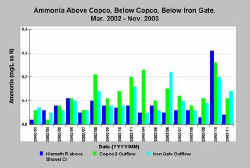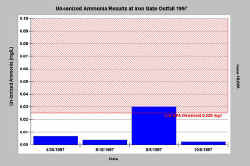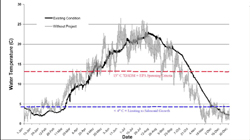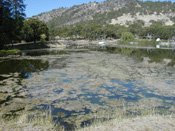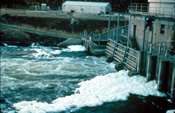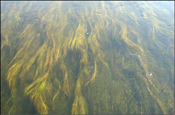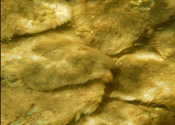KHP Impacts on Water Quality
- High nutrient concentrations below Iron Gate Dam stimulate the growth of attached algae and aquatic plants, and create (alkaline) pH and dissolved oxygen levels that are stressful to salmonids.
- Water released from Iron Gate Dam is warmer than natural in fall and cooler than natural in the spring, which has harms salmon spawning and rearing downstream.
- Copco and Iron Gate Reservoirs, the most downstream of the KHP, provide ideal conditions for outbreaks of the toxic blue-green algal species Microcystis aeruginosa that occurs at hazardous levels in these reservoirs and has been now been found in the Klamath River all the way to the estuary.
Klamath Hydroelectric Project reservoirs have a deleterious effect on downstream water quality, impacting stream temperatures, depressing dissolved oxygen (D.O.), and elevating pH levels (Kier Associates, 1991, QVIR, 2006). The most apparent problem is the blue-green algae blooms, which develop in these slowed, warmed warm waters and, following their release from the reservoirs, create degraded conditions downstream (CDWR, 1986). Nitrogen levels were about 3.5 times higher below the lake than in the streams flowing into the lake. Aphanizomenon flos-aquae is a common algal species in Iron Gate and Copco reservoirs during the summer season, indicating the nitrogen fixing is likely occurring there as well.
Nutrients
The reservoirs are sinks for nitrogen and phosphorus. Nitrogen concentrations (and phosphorus concentrations to a lesser extent), are predicted to increase under a dam removal scenario. See the Free-flowing vs. Lake page for information on how nutrient retention in KHP reservoirs compares to free-flowing reaches of the Klamath River.
Ammonia
Another way that the reservoirs affect Klamath River water quality is by increasing concentrations of ammonia. Ammonia is a nitrogen-containing compound that is toxic to fish. It is also a nutrient for aquatic plants and algae. The data clearly show that ammonia concentrations are often substantially higher below Iron Gate Dam than they are upstream, above Copco Reservoir (QVIC 2006). These higher ammonia concentrations represent a substantial zone of toxicity risk to the fish in the river below Iron Gate.
Ammonia's toxicity to fish depends on its concentration, stream temperature, pH level, and the duration of exposure (U.S. EPA 1999). As pH and temperature increase, ammonia converts from ammonium ions to dissolved ("unionized") ammonia that is lethal to salmonids at very low levels. For example, at 25 degrees C and at a pH of 9.0, 38% of the ammonia would be dissolved (Goldman and Horne 1983). Temperatures frequently exceed 25 degrees C and pH 9.0 in the Klamath River during summer. Unionized ammonia is highly stressful to salmonids (see Fish Health)
North Coast Regional Water Quality Control Board staff measured pulses of unionized ammonia coming out of Iron Gate Reservoir in 1997. A massive death of fish at a government fish trap downstream at Orleans (Big Bar) was attributed to poor water quality (Halstead, 1997). It coincided with the highest concentrations of unionized ammonia pulses from Iron Gate listed in the NCRWQCB staff report.
Recovery Zone
Downstream of Iron Gate Reservoir is an area referred to as a "recovery zone" having prolific growths of rooted aquatic plants (macrophytes) and attached algae. These organisms thrive on the river's warm water and high nutrient concentrations here. Nutrients are removed from the water column (retained) and assimilated into the growing algae and macrophytes. Due to extreme algal activity in the recovery zone, daily fluctuations in water quality parameters like dissolved oxygen (D.O.) and pH can be adverse for salmonids, but the nutrient retention here lowers the downstream nutrient concentrations. Therefore, while water quality is degraded in the recovery zone, itself, the nutrient uptake in the river there improves the quality of the water downstream of it.
If dams were removed from the river, this recovery zone would expand upstream and water quality would be improved around Iron Gate, where salmon and steelhead concentrate.
Nutrient Spiraling
While the ability of the attached algae and macrophytes to assimilate nutrients in the recovery zone is substantial, and while it does benefit water quality downstream, this ability is not unlimited (Asarian and Kann 2006a). Thus, a substantial amount of nutrient escapes to travel far downstream, fueling algal and macrophyte growth that continues to degrade pH and D.O. conditions in the lower reaches of the Klamath River.
This condition of algae and macrophytes dying, decaying, and their still-living segments floating downstream to cause still more nutrient pollution late into the summer, and over long reaches of the Klamath River, is part of a process known as "nutrient spiraling".
Dissolved Oxygen
Dissolved oxygen (D.O.) levels can sag at night when photosynthetic activity ceases and algae consumes oxygen through respiration. Salmon and steelhead swimming ability drops when D.O. is less than 7 ppm.
The U.S. Fish and Wildlife Service measured D.O. levels lethal for salmonids at the Big Bar downstream migrant trap (at left) in the early morning of August 10, 1997 (Halstead, 1997). Service scientists suspected severe water quality problems because even warm water fish like suckers and dace were dying, not just salmonids. The 1997 event appears to have been anomalous (perhaps even erroneous data) because continuous water quality probes deployed at many mainstem stations from 2001 to present have not detected similarly low D.O.
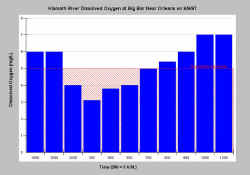 |
|
| Hourly dissolved oxygen levels of the Klamath River at the Big Bar fish trap on August 9-10, 1997. Data from USFWS, Arcata. Chart from KRIS Version 3.0 |
Water Temperature
Another important and well-recognized problem with the Klamath Hydroelectric Project is its deleterious effects on the river's water temperatures. The U.S. EPA (2003) recommends that temperatures for salmon spawning and egg incubation not exceed 13 C, measured as a "floating maximum weekly average". During the fall chinook salmon spawning season Klamath River temperatures exceed this goal for weeks because of a "thermal lag" created by the sheer temperature mass represented by the water in Iron Gate Reservoir (at right). This lag can delay chinook salmon spawning activity, decrease fertility, lower the number of eggs and, ultimately, the reproductive success of the salmon (McCullough, 1999).
Just as the Iron Gate thermal lag can harm the spawning of adult salmon in the fall, it also causes water temperatures to remain too low for good growth by young salmon (anything less than 4 degrees C) for several weeks in spring. This slows the growth of fry-sized salmon, decreases their feeding, and more than likely reduces their survival (QVIR, 2006). The Yurok Tribe (2006) expressed concern that KHP-driven temperature shifts create select pressure that is moving fall chinook runs later and later in the season.
References
Asarian, E. J. Kann, and W. Walker. 2010. River Nutrient Loading and Retention Dynamics in Free-Flowing Reaches, 2005-2008. Final Technical Report to the Yurok Tribe Environmental Program, Klamath, CA. 59pp + appendices.
Asarian, E. J. Kann, and W. Walker. 2009. Multi-year Nutrient Budget Dynamics for Iron Gate and Copco Reservoirs, California. Prepared by Riverbend Sciences, Kier Associates, Aquatic Ecosystem Sciences, and William Walker for the Karuk Tribe Department of Natural Resources, Orleans, CA. 55pp + appendices.
Asarian, E. and J. Kann. 2006. Klamath River Nitrogen Loading and Retention Dynamics, 1996-2004. Kier Associates Final Technical Report to the Yurok Tribe Environmental Program, Klamath, California. 56pp + appendices.
California Dept. of Water Resources. 1986. Shasta/Klamath rivers water quality study. Northern District. Red Bluff, CA. At KRIS Web site. [88 kb]
Federal Energy Regulatory Commission. 2007. Final Environmental Impact statement for the Klamath Hydroelectric Project, Docket No. P-2082-027. 11/18/07. U.S. DOE, FERC, Washington D.C. Download zipped document. (22 separate files.)
Goldman, C.R. and A.J. Horne. 1983. Limnology. McGraw-Hill, Inc. New York. 464 pp.
Halstead, B. G. 1997. Memorandum to Bruce Gwynne of the California North Coast Regional Water Quality Control Board concerning water quality in the Klamath River. Unpublished letter of 23 September 1997. US Fish and Wildlife Service. Coastal California Fish and Wildlife Office. Arcata, CA. 14 pp. [172 Kb] At KRIS Web site.
Hoopa Valley Tribe Environmental Protection Agency (HVTEPA). 2008. Water Quality Control Plan Hoopa Valley Indian Reservation. Approved September 11, 2002, Amendments Approved February 14, 2008. Hoopa Tribal EPA. Hoopa, CA. 285 p.
Kann, J., and E. Asarian. 2005. 2002 Nutrient and Hydrologic Loading to Iron Gate and Copco Reservoirs, California. Kier Associates Final Technical Report to the Karuk Tribe Department of Natural Resources, Orleans, California. 59pp + appendices.
Kann, J. and E. Asarian. 2007. Nutrient Budgets and Phytoplankton Trends in Iron Gate and Copco Reservoirs, California, May 2005 - May 2006. Final Technical Report to the State Water Resources Control Board, Sacramento, California. 81pp + appendices.
Karuk Tribe of California. 2007. Response to PacifiCorps Causes and Effects of Nutrient Conditions in the Upper Klamath River, and PacifiCorps Responses to Comments from Various Stakeholders on the September 2006 FERC DEIS For Hydropower License for the Klamath Hydroelectric Project. Submitted to FERC by the Karuk Tribe of California, Orleans, CA. 30pp.
Kier Associates. 1991. Draft Upper Basin Amendment to the Long Range Plan for the Klamath River Basin Conservation Area Fishery Restoration Program. U.S. Fish and Wildlife Service, Klamath River Fishery Resource Office. Yreka, CA.
Kier Associates. 1999. Mid-term evaluation of the Klamath River Basin Fisheries Restoration Program. Sausalito, CA. Prepared for the Klamath River Basin Fisheries Task Force. 303 pp [4.7 Mb]. At KRIS Web site.
McCullough, D. 1999. A Review and Synthesis of Effects of Alterations to the Water Temperature Regime on Freshwater Life Stages of Salmonids, with Special Reference to Chinook Salmon. Columbia Intertribal Fisheries Commission, Portland, OR. Prepared for the U.S. Environmental Protection Agency Region 10. Published as EPA 910-R-99-010. [965 Kb]. At KRIS Web site.
McIntosh, B. A. and H. W. Li. 1998. Abstract and other information regarding the Final report - Klamath Basin Pilot Project: Coldwater refugia study and videography. Oregon State University . [3kb] At KRIS Web site.
North Coast Regional Water Quality Control Board. 2001. Water Quality Control Plan for the North Coast Region. Staff report adopted by the North Coast Regional Water Quality Control Board on June 28, 2001. Santa Rosa, CA. 124 p. [1.4 Mb]. At KRIS Web site.
ODFW (Oregon Department of Fish and Wildlife). 1996. Summary of 1996 Klamath River sampling. Oregon Department of Fish and Wildlife, Klamath Falls, OR. 12 p.
Oregon Department of Environmental Quality (ODEQ). 2002. Upper Klamath Lake Drainage Total Maximum Daily Load (TMDL) and Water Quality Management Plan (WQMP) Response to Public Comments. May 2002.
PacifiCorp. 2004. Final License Application for the Klamath River Hydroelectric Project (FLA). Filed with the Federal Energy Regulatory Commission on February 25, 2004. PacifiCorp,Portland, OR. 7000 p. http://www.pacificorp.com/Article/Article28613.html
PacifiCorp. 2006. Appendix B Causes and Effects of Nutrient Conditions in the Upper Klamath River. PacifiCorp, Portland, Oregon.
Quartz Valley Indian Community. 2006. Recommended Terms and Conditions for the Klamath Hydroelectric Project (FERC #2082-027). Filed with FERC on March 29, 2006. Prepared with assistance from Kier Associates, Blue Lake, CA. 57 p.
Quartz Valley Indian Reservation. 2004. Comments and Additional Study Requests, PacifiCorp Final License Application (Project No. 2082-027). Filed with FERC on April 24, 2004. Quartz Valley Indian Reservation, Fort Jones, CA. 35 pp.
U.S. Environmental Protection Agency. 2003. EPA Region 10 Guidance for Pacific EPA Project # 910-B-03-002. Northwest State and Tribal Temperature Water Quality Standards. Region 10 U.S. EPA, Seattle WA. 57 p.
Yurok Tribe. 2006. Recommended Terms and Conditions for the Klamath Hydroelectric Project (FERC #2082-027). Filed with FERC on March 28, 2006. Yurok Tribe, Klamath, CA. 78 p.

